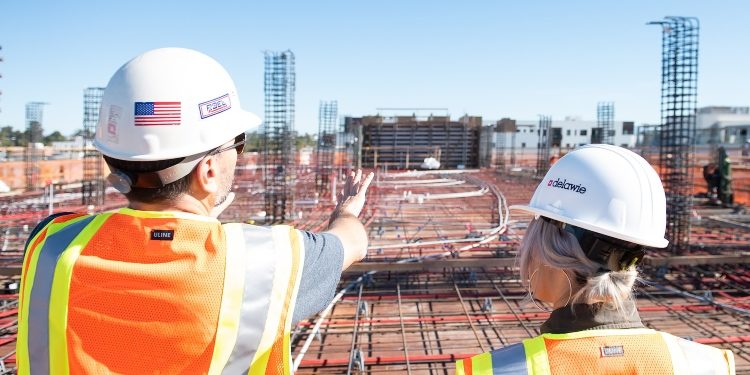First aid supplies are essential in workplaces, specifically construction work sites since they give wounded workers immediate medical care. Construction sites are more prone to the inherent risk of accidents or injuries, and sufficient first aid supplies are essential to ensure worker safety.
This content will walk readers through the mandatory first aid requirements for construction sites covered under First Aid Regulations 1981 and how to prevent workplace injuries while keeping the workforce safe.
Following these regulations help minimize the risk of injuries and handle medical crises quickly.
What are First Aid Requirements for Construction Sites?
The Health and Safety (First Aid) Regulations 1981 covers the mandatory requirements for first aid on any worksite. These regulations require employers and supervisors to have appointed persons at work with necessary first aid supplies and skills to assist casualties.
When talking specifically about construction sites, this industry is more prone to severe health and safety hazards, and so requires effective first aid practices and facilities to ensure workforce safety and well-being, and so requires regular first aid risk assessment.
It accounts for having the following essentials always ready; a first aid box with necessary supplies should be available. It must have bandages, antiseptic treatments, and sticky tape to treat the emergency.
To prevent or minimize additional injuries or infections, personal protective equipment (PPE) such as gloves, eye shields, and face masks must always be accessible. Automated external defibrillators (AEDs) to act promptly against cardiac emergencies.
Besides this, regular equipment maintenance and inspection are essential to ensure their practical functionality during accidents, injuries, ill health, or other emergencies.
Let’s have a look at the necessary first aid equipment based on their level of severity and use:
Basic First Aid Equipment
Following is the essential first aid equipment necessary at work:
First Aid Kits
The basic first aid contents include supplies for treating common wounds or injuries. Although the contents may vary depending on the laws and the size of the workforce, some basic supplies include the followings:
- Adhesive bandages in different sizes
- Sterile pads
- Sticky tape
- Wipes or antiseptic solutions
- Disposable gloves
- Tweezers & Scissors
- CPR barrier mask
- Splinting supplies
- Cold towels
- Painkillers
- Handbook on first aid
First Aid Location & Accessibility
Positioning and locating first aid kits is also a crucial step to ensure everyone’s safety. They must be placed in a common area to be easily accessible for everyone in an emergency. Some examples include break rooms, shared spaces, or supervisor offices.
To ensure the quality of materials and proper working of first aid kits, they must be stored sufficiently to protect them from dust, moisture, or extreme temperatures.
Responsible persons must always prepare first aid kits by performing routine inspections to replace exhausted or expired supplies.
Personal Protective Equipment (PPE)
Some common examples of PPE include:
- Gloves
Gloves are one of the necessary PPE while working on a site. They help prevent contamination or transmission of infectious diseases for both the first aider and the victim. Gloves also play a crucial role in avoiding hands from hazardous chemicals or bodily fluids that an individual might come in contact with, intentionally or unintentionally.
- Eye Protection
Eye protection is also necessary to prevent the eyes from dust, debris, chemical splashes, or other damage. Safety goggles or glasses with side shields must be readily available on a work site and a first aid box to treat eye injuries or prevent further damage.
- Face Masks
Protecting the first responder and the injured person from respiratory illnesses and airborne toxins requires face masks. It could be surgical masks or N95 respirators. They are best appropriate when performing mouth-to-mouth resuscitation or when there is a chance of being exposed to dangerous substances or infectious diseases.
- Respirators
Respirators are also an integral PPE type used in environments where there is a risk of inhaling hazardous substances or materials, or a person may be exposed to airborne dust particles.
Respirators are appropriate when working on construction work sites, specifically when the work involves demolition, asbestos removal, painting, or other relevant work processes. It is essential to choose this PPE carefully to ensure they are fit for the work and workers’ overall health and safety.
Advanced First Aid Equipment
Advanced first aid equipment responds promptly to severe medical emergencies on construction sites to ensure workplace safety. Some of the common types are:
Automated External Defibrillator (AED)
Automated external defibrillators (AEDs), or life-saving devices, restore normal heart rhythm during cardiac arrest.
AEDs examine the heart’s electrical activity and direct the user through the procedure with audible and visual cues. Anyone with basic to advance knowledge of AED can easily use these devices.
Location & Accessibility of AED
It is essential to place AEDs in places conveniently accessible areas for everyone at work. Keeping them in wall-mounted cabinets is ideal. The best practice is that they are readily available at the location within a few minutes, as they can make a difference between life and death.
Backboards & Stretchers
Stretchers and backboards are also crucial components of first aid equipment for transporting injured workers and preventing further injuries.
There are numerous types of stretchers and backboards used in most work sites. Terrain and cramped quarters frequently call for specialized stretchers; backboards are also available at most construction sites.
Scoop stretchers and basket stretchers are also frequently used in construction environments. These stretchers ensure injured workers can be safely moved to the location to treat them.
Maintenance & Inspection of First Aid Equipment
Below are some things to keep in mind to ensure necessary maintenance and inspection:
- Regularly inspecting first aid kits to ensure they are adequately supplied, in good order, and available for use in an emergency is essential
- Inspecting and replacing depleted equipment regularly to ensure their proper working
- Providing the workforce with necessary information, training, and guidance to ensure they follow safe work practices and first aid procedures to help those in need
Conclusion
First aid arrangements and equipment are a necessity of every workplace; when discussing construction work sites, employers and supervisors need to pay close attention to accidents or injuries occurring on site and what safe practices can help minimize them.
David Prior
David Prior is the editor of Today News, responsible for the overall editorial strategy. He is an NCTJ-qualified journalist with over 20 years’ experience, and is also editor of the award-winning hyperlocal news title Altrincham Today. His LinkedIn profile is here.












































































